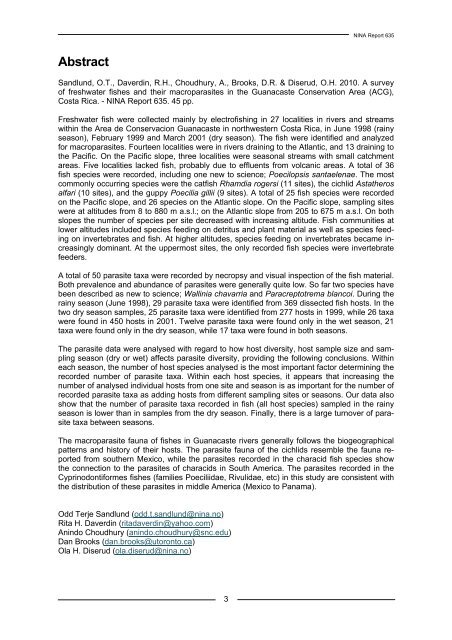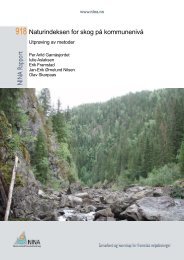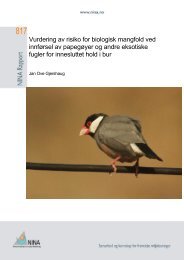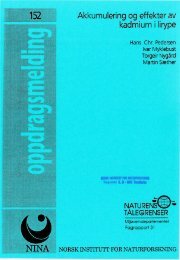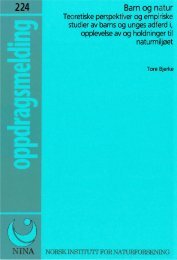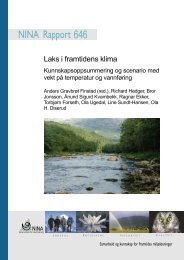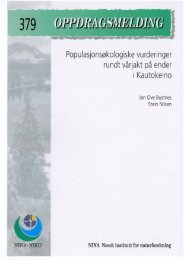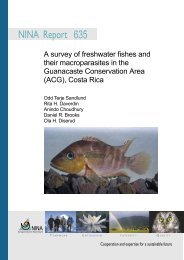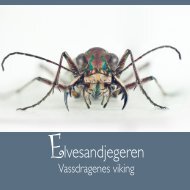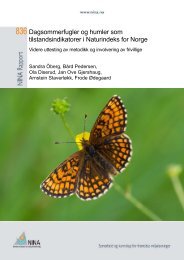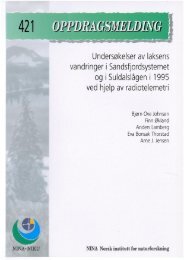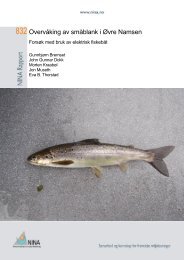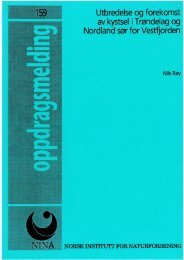A survey of freshwater fishes and their macroparasites in the ... - NINA
A survey of freshwater fishes and their macroparasites in the ... - NINA
A survey of freshwater fishes and their macroparasites in the ... - NINA
Create successful ePaper yourself
Turn your PDF publications into a flip-book with our unique Google optimized e-Paper software.
Abstract<br />
3<br />
<strong>NINA</strong> Report 635<br />
S<strong>and</strong>lund, O.T., Daverd<strong>in</strong>, R.H., Choudhury, A., Brooks, D.R. & Diserud, O.H. 2010. A <strong>survey</strong><br />
<strong>of</strong> <strong>freshwater</strong> <strong>fishes</strong> <strong>and</strong> <strong><strong>the</strong>ir</strong> <strong>macroparasites</strong> <strong>in</strong> <strong>the</strong> Guanacaste Conservation Area (ACG),<br />
Costa Rica. - <strong>NINA</strong> Report 635. 45 pp.<br />
Freshwater fish were collected ma<strong>in</strong>ly by electr<strong>of</strong>ish<strong>in</strong>g <strong>in</strong> 27 localities <strong>in</strong> rivers <strong>and</strong> streams<br />
with<strong>in</strong> <strong>the</strong> Area de Conservacion Guanacaste <strong>in</strong> northwestern Costa Rica, <strong>in</strong> June 1998 (ra<strong>in</strong>y<br />
season), February 1999 <strong>and</strong> March 2001 (dry season). The fish were identified <strong>and</strong> analyzed<br />
for <strong>macroparasites</strong>. Fourteen localities were <strong>in</strong> rivers dra<strong>in</strong><strong>in</strong>g to <strong>the</strong> Atlantic, <strong>and</strong> 13 dra<strong>in</strong><strong>in</strong>g to<br />
<strong>the</strong> Pacific. On <strong>the</strong> Pacific slope, three localities were seasonal streams with small catchment<br />
areas. Five localities lacked fish, probably due to effluents from volcanic areas. A total <strong>of</strong> 36<br />
fish species were recorded, <strong>in</strong>clud<strong>in</strong>g one new to science; Poecilopsis santaelenae. The most<br />
commonly occurr<strong>in</strong>g species were <strong>the</strong> catfish Rhamdia rogersi (11 sites), <strong>the</strong> cichlid Asta<strong>the</strong>ros<br />
alfari (10 sites), <strong>and</strong> <strong>the</strong> guppy Poecilia gillii (9 sites). A total <strong>of</strong> 25 fish species were recorded<br />
on <strong>the</strong> Pacific slope, <strong>and</strong> 26 species on <strong>the</strong> Atlantic slope. On <strong>the</strong> Pacific slope, sampl<strong>in</strong>g sites<br />
were at altitudes from 8 to 880 m a.s.l.; on <strong>the</strong> Atlantic slope from 205 to 675 m a.s.l. On both<br />
slopes <strong>the</strong> number <strong>of</strong> species per site decreased with <strong>in</strong>creas<strong>in</strong>g altitude. Fish communities at<br />
lower altitudes <strong>in</strong>cluded species feed<strong>in</strong>g on detritus <strong>and</strong> plant material as well as species feed<strong>in</strong>g<br />
on <strong>in</strong>vertebrates <strong>and</strong> fish. At higher altitudes, species feed<strong>in</strong>g on <strong>in</strong>vertebrates became <strong>in</strong>creas<strong>in</strong>gly<br />
dom<strong>in</strong>ant. At <strong>the</strong> uppermost sites, <strong>the</strong> only recorded fish species were <strong>in</strong>vertebrate<br />
feeders.<br />
A total <strong>of</strong> 50 parasite taxa were recorded by necropsy <strong>and</strong> visual <strong>in</strong>spection <strong>of</strong> <strong>the</strong> fish material.<br />
Both prevalence <strong>and</strong> abundance <strong>of</strong> parasites were generally quite low. So far two species have<br />
been described as new to science; Wall<strong>in</strong>ia chavarria <strong>and</strong> Paracreptotrema blancoi. Dur<strong>in</strong>g <strong>the</strong><br />
ra<strong>in</strong>y season (June 1998), 29 parasite taxa were identified from 369 dissected fish hosts. In <strong>the</strong><br />
two dry season samples, 25 parasite taxa were identified from 277 hosts <strong>in</strong> 1999, while 26 taxa<br />
were found <strong>in</strong> 450 hosts <strong>in</strong> 2001. Twelve parasite taxa were found only <strong>in</strong> <strong>the</strong> wet season, 21<br />
taxa were found only <strong>in</strong> <strong>the</strong> dry season, while 17 taxa were found <strong>in</strong> both seasons.<br />
The parasite data were analysed with regard to how host diversity, host sample size <strong>and</strong> sampl<strong>in</strong>g<br />
season (dry or wet) affects parasite diversity, provid<strong>in</strong>g <strong>the</strong> follow<strong>in</strong>g conclusions. With<strong>in</strong><br />
each season, <strong>the</strong> number <strong>of</strong> host species analysed is <strong>the</strong> most important factor determ<strong>in</strong><strong>in</strong>g <strong>the</strong><br />
recorded number <strong>of</strong> parasite taxa. With<strong>in</strong> each host species, it appears that <strong>in</strong>creas<strong>in</strong>g <strong>the</strong><br />
number <strong>of</strong> analysed <strong>in</strong>dividual hosts from one site <strong>and</strong> season is as important for <strong>the</strong> number <strong>of</strong><br />
recorded parasite taxa as add<strong>in</strong>g hosts from different sampl<strong>in</strong>g sites or seasons. Our data also<br />
show that <strong>the</strong> number <strong>of</strong> parasite taxa recorded <strong>in</strong> fish (all host species) sampled <strong>in</strong> <strong>the</strong> ra<strong>in</strong>y<br />
season is lower than <strong>in</strong> samples from <strong>the</strong> dry season. F<strong>in</strong>ally, <strong>the</strong>re is a large turnover <strong>of</strong> parasite<br />
taxa between seasons.<br />
The macroparasite fauna <strong>of</strong> <strong>fishes</strong> <strong>in</strong> Guanacaste rivers generally follows <strong>the</strong> biogeographical<br />
patterns <strong>and</strong> history <strong>of</strong> <strong><strong>the</strong>ir</strong> hosts. The parasite fauna <strong>of</strong> <strong>the</strong> cichlids resemble <strong>the</strong> fauna reported<br />
from sou<strong>the</strong>rn Mexico, while <strong>the</strong> parasites recorded <strong>in</strong> <strong>the</strong> characid fish species show<br />
<strong>the</strong> connection to <strong>the</strong> parasites <strong>of</strong> characids <strong>in</strong> South America. The parasites recorded <strong>in</strong> <strong>the</strong><br />
Cypr<strong>in</strong>odontiformes <strong>fishes</strong> (families Poeciliidae, Rivulidae, etc) <strong>in</strong> this study are consistent with<br />
<strong>the</strong> distribution <strong>of</strong> <strong>the</strong>se parasites <strong>in</strong> middle America (Mexico to Panama).<br />
Odd Terje S<strong>and</strong>lund (odd.t.s<strong>and</strong>lund@n<strong>in</strong>a.no)<br />
Rita H. Daverd<strong>in</strong> (ritadaverd<strong>in</strong>@yahoo.com)<br />
An<strong>in</strong>do Choudhury (an<strong>in</strong>do.choudhury@snc.edu)<br />
Dan Brooks (dan.brooks@utoronto.ca)<br />
Ola H. Diserud (ola.diserud@n<strong>in</strong>a.no)


